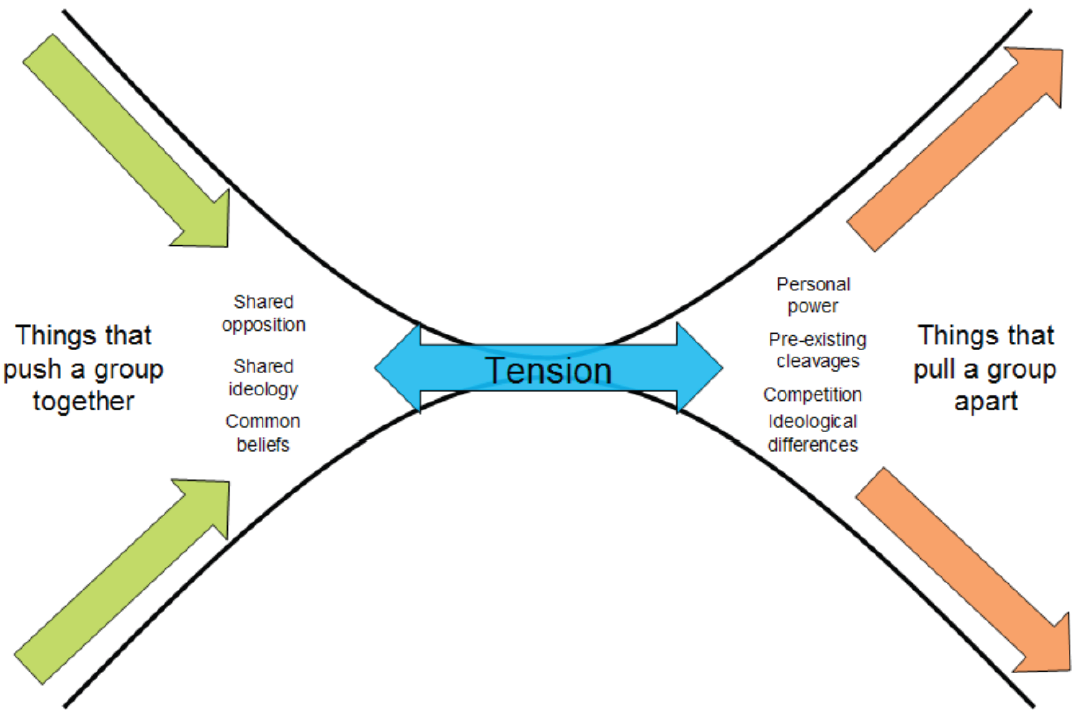
- Tuesday, September 12th, 2017
- behind the numbers
-
What makes for a good investment team? How can you analyze the capabilities and dynamics of a team when you don’t see it in operation day to day?
Those questions should provide ample fodder for one of the sessions at my upcoming workshoptjb research | The workshop will be held in Minneapolis on November 7-8. Attendees also participate in a six-week online workgroup and receive a one-on-one consultation specific to their organization. on due diligence and manager selection. Assessing a team involves much more than looking at the bios and apparent track records of those involved.
What pushes a group together and what pulls the individuals apart? This image, taken from a presentation from the spy consortium Five Eyes,The Intercept | It comes from a deck on “The Art of Deception,” published online by The Intercept. conveys some of the factors involved:
Notably left out of the diagram? Money. Interestingly, it could appear on either side at different points in time. (That’s certainly true when it comes to investment organizations.)
The relationships that foster success can fracture more easily than we think. We see that in other domains, especially in the entertainment world. The recent death of Jerry Lewis triggered looks back at his partnership with Dean Martin, and their fabulous success, schism, and reconciliation years later.People | Here’s an example of one of the articles.
The ups and downs of famous musical groups are well chronicled; VH1’s Behind the MusicYouTube | Episodes are available via YouTube. in particular fed off of “the success, tragedy, and triumphs” defined by drugs, sex, rock and roll — and waves of love and hate. History of the EaglesAmazon | In addition to the documentary, there is also a concert DVD included. is a particularly good guide to how group interactions change over time.
Sports fans might think of Kyrie Irving’s demand to be traded this summer, apparently because he no longer wanted to share the spotlight with LeBron James. (For Minnesotans, it brings back bad memories of Stephon Marbury deciding he didn’t want to play in the shadow of Kevin Garnett.) There are lots of “what might have been” stories out there.
But back to investment teams. If you look at the “people” section of most due diligence reports, you’ll find that there’s rarely anything that even hints at the fact that the members of the team are living, breathing people. Organizations are messy, and the one that produced that historical track record is not the same one around today, even if the roster is identical.
Times change, people change, circumstances change. What used to be creative tension can turn into destructive tension. The emotion of allegiance can become the emotion of alienation.
And that money thing can really get in the way. Partners that have struggled together (“all for one and one for all”) can start fighting over the spoils when they finally arrive, even when there’s more than enough to go around. Those who had a marriage of convenience can break with each other suddenly; “They always hated each other,” said someone of a successful firm that came apart not too long ago.
This is a people business and how those people are brought together and work together is critically important, but there’s usually no focus on team dynamics. Some say you can’t really get a good look. Is that true? Does that mean you shouldn’t try? How would you go about doing so? If it’s impossible to assess the reality of a situation, why don’t we admit that those “people” ratings are pretty superficial?
There can hardly be anything more important than understanding this aspect of an organization, yet we barely scratch the surface. The nature of teams should be top of mind for those evaluating investment entities, but very little time is spent in that regard. (We’ll remedy that in the workshop.)
For now, perhaps you should do this. Imagine that the object of your review is the subject of a reality show — let’s call it Behind the Numbers. Where has the group been? What’s going on now? What does the future hold? Are the people moving together or apart?

